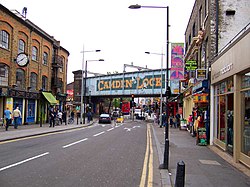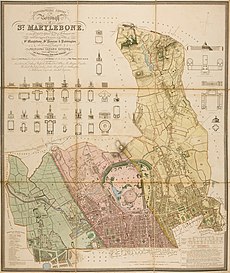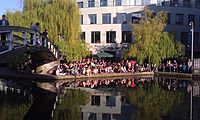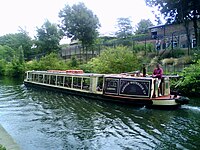Camden Town
| Camden Town | |
| Middlesex | |
|---|---|
 Shopping street near the market | |
| Location | |
| Grid reference: | TQ295845 |
| Location: | 51°32’28"N, 0°8’36"W |
| Data | |
| Post town: | London |
| Postcode: | NW1 |
| Dialling code: | 020 |
| Local Government | |
| Council: | Camden |
| Parliamentary constituency: |
Holborn and St Pancras |
Camden, familiarly known as Camden Town, is a town of Middlesex deep within the London conurbation, to the north-east of Regent's Park. It is well known for Camden Town Market.
At Camden Town a knot of railway lines, A-roads and a branch of the Grand Union Canal meet, creating a very busy urban centre.
Originally this area was part of the manor of Kentish Town and the parish of St Pancras, but it was laid out as a residential district from 1791. Later, Camden Town became an important location during the early development of the railways, which reinforced its position on the London canal network. The area's industrial economic base has been replaced by service industries such as retail, tourism and entertainment. The area now hosts street markets and music venues that are strongly associated with alternative culture.
Name
Camden Town is named after Charles Pratt, 1st Earl Camden. His earldom was styled after his estate, Camden Place near Chislehurst in Kent, formerly owned by the historian William Camden.[1] The name, which appears on the Ordnance Survey map of 1822,[2] was later applied to the early-20th-century Camden Town Group of artists.[3]
History

Urban development
The emergence of the industrial revolution in the 19th century meant Camden was the North Western Railway's terminal stop in 1837. It was where goods were transported off the tracks and onto the roads of London by 250 000 workhorses.[4] The whole area was adapted to a transportation function: The Roundhouse (1846), Camden Lock and The Stables were examples of this.
Camden Town stands on land that was once the manor of Kentish Town. Sir Charles Pratt, a radical 18th-century lawyer and politician, acquired the manor through marriage. In 1791, he started granting leases for houses to be built in the manor. In 1816, the Regent's Canal was built through the area.[5] Up to at least the mid-20th century, Camden Town was considered an "unfashionable" locality.[6]
The Camden Markets, which started in 1973 and have grown since then, attract many visitors. In 1993 a terrorist bomb blast injured 18 people on Camden High Street. On 9 February 2008, Camden Canal market suffered a major fire, but there were no injuries.[7] It later reopened as Camden Lock Village,[8] until closed in 2015 for redevelopment.
Economy

At the end of the 20th century, entertainment-related businesses began moving into the area, and a Holiday Inn was built abutting the canal. A number of retail and food chain outlets replaced independent shops, driven out by high rents and redevelopment. Restaurants with a variety of culinary traditions thrived, many of them near the markets, on Camden High Street and its side streets, Parkway, Chalk Farm Road, and Bayham Street. The plan to redevelop the historic Stables Market led to a steel and glass extension, built on the edges of the site in 2006, and increased the market's capacity.
Camden street markets
Camden is well known for its markets. These date from 1974 or later, except for Inverness Street market, for over a century a small food market serving the local community,[9] though by 2013 all foodstuff and produce stalls had gone and only touristy stalls remained.
Camden Lock Market proper started in a former timber yard in 1973, and is now surrounded by five more markets: Buck Street market, Stables market, Camden Lock Village, and an indoor market in the Electric Ballroom. The markets are a major tourist attraction at weekends, selling goods of all types, including fashion, lifestyle, books, food, junk/antiques and more bizarre items; they and the surrounding shops are popular with young people, in particular, those searching for "alternative" clothing. While originally open on Sundays only,[10] market activity later extended throughout the week, though concentrating on weekends.
Regent's Canal

Regent's Canal runs through the north end of Camden Town.

Canal boat trips along the canal from Camden Lock are popular, particularly in summer. Many of the handrails by the bridges show deep marks worn by the towropes by which horses pulled canal barges until the 1950s, and it is still possible to see ramps on the canal bank designed to assist horses that fell in the canal after being startled by the noise of a train. A regular waterbus service operates along the Regent's Canal from Camden Lock. Boats depart every hour during the summer, heading westward around Regent's Park, calling at London Zoo and on towards Maida Vale. Sightseeing narrow-boat trips run from Camden Lock to Little Venice.
Camden Lock is a regularly used traditional manually operated double canal lock operating between widely separated levels. A large complex of weekend street markets operates around the Lock.
The towpath is a pedestrian and cycle route which runs continuously from Little Venice through Camden Lock to the Islington Tunnel.[11]
Media

National
To the north of Camden Town station and running along the canal is a modern pop art complex designed by Terry Farrell as the studios of the former TV-am, now used by MTV[5] but retaining TV-am's eggcup sculptures along the roof line. Associated Press Television News has its head office in a former gin warehouse near Camden Lock called "The Interchange".
Local
- The Camden New Journal is a free, independent weekly newspaper that covers Camden and the wider borough
- Camden tv: Web site with short films about Camden.[12]
In popular culture
In literature
- Author Charles Dickens, a onetime resident of Camden Town,[13] placed various characters and places in his stories there as well:
- Bob Cratchit's family in A Christmas Carol (1843);
- The Micawbers in David Copperfield (1850);
- In Dombey and Son (1846–1848), a description of the building of the London and Birmingham Railway, includes a trip through Camden Town.[14]
- The Phoenix and the Carpet, E. Nesbit's 1904 children's novel, is set at 18 Camden Terrace, Camden Town.[15]
- Business Girls, John Betjeman's poem is set in Camden Town.[16]
- The climax of John le Carré's 1974 spy novel Tinker Tailor Soldier Spy occurs in a safe house at 5 Lock Gardens in Camden Town, a fictitious address modelled after real-life St. Mark's Crescent.
In film and television
- Withnail and I (the 1986 cult comedy film)[17] is set in Camden Town in 1969.[18]
- The Tall Guy (1989 comedy film): the titular protagonist is seen frequently bicycling to his flat set in Camden Town.
- Happy-Go-Lucky (a 2008 film) largely takes place in Camden Town.
- The Lady in the Van (2015 film) tells the story of a homeless woman who parked her van in Alan Bennett's Camden driveway (in Gloucester Crescent) and lived there for 15 years.
- Amy, a 2015 documentary film based on Amy Winehouse's life and death features footage and exclusive images of Winehouse in Camden during her life.
- Been So Long, a 2018 film, is set in Camden Town.
- 101 Dalmatian Street, a 2019 Disney animated series, is set in Camden Town.
- Peaky Blinders; the The second series refers to Camden Town Gangs
Outside links
| ("Wikimedia Commons" has material about Camden Town) |
References
- ↑ Walford, Edward. "Camden Town and Kentish Town." Old and New London: Volume 5. London: Cassell, Petter & Galpin, 1878. 309–324. British History Online. Web. 18 September 2018. http://www.british-history.ac.uk/old-new-london/vol5/pp309-324.
- ↑ Mills 2001, p. 37
- ↑ Mills 2001, p. 38
- ↑ Town, Camden Town Unlimited and Euston (2019-07-12). "The History of Camden Market's 'The Stables'" (in en). https://medium.com/camden-town-unlimited/the-history-of-camden-markets-the-stables-69363507c02f.
- ↑ 5.0 5.1 Hibbert, Christopher (2008). London Encyclopaedia. Macmillan London Ltd. p. 123. ISBN 978-1-4050-4924-5.
- ↑ Dunton, Larkin (1896). The World and Its People. Silver, Burdett. p. 29. https://archive.org/details/worldanditspeop05duntgoog.
- ↑ "Blaze ravages London market area". BBC (BBC). 9 February 2008. http://news.bbc.co.uk/1/hi/uk/7237119.stm.
- ↑ "Camden Market continues strongly". MintTwist. 22 February 2008. http://www.minttwist.com/blog/2008/02/22/camden-market-continues-strongly-after-fire/.
- ↑ JOSIE HINTON (11 February 2010). "Camden's oldest market in Inverness Street 'could go under'". Camden New Journal. http://camdennewjournal.com/article/camdens-oldest-market-inverness-street-could-go-under?sp=1&sq=Camden%2527s%2520oldest%2520market%2520in%2520Inverness%2520Street%2520%2527could%2520go%2520under%2527.
- ↑ "Open since 1974 – It all started with 16 stalls". Camdenlock.net. https://www.camdenmarket.com/about-us.
- ↑ "Regent's Canal cycling route - 4.6 miles". https://canalrivertrust.org.uk/enjoy-the-waterways/cycling/canal-cycling-routes/regents-canal-cycling-route.
- ↑ "Welcome". http://www.camden.tv/.
- ↑ Pope-Hennessy, Una (1945). "The Family Background". Charles Dickens 1812–1870. London: Chatto and Windus. p. 11.
- ↑ "Camden's famous faces". Camden New Journal. 23 April 2009. http://www.thecnj.com/review/2009/042309/stgeorge042309_03.html.
- ↑ Rosenberg, Teya (2006). "Generic Manipulation and Mutation: E. Nesbit's Psammead Series as Early Magical Realism". in Jones, Raymond E.. E. Nesbit's Psammead Trilogy: A Children's Classic at 100. p. 72. ISBN 9780810854017. https://books.google.com/books?id=FLERfuhpRSMC&pg=PA72.
- ↑ Wright, Jane (2006). "Betjeman's great defender". Camden New Journal. http://www.thecnj.com/review/020906/features020906_01.html.
- ↑ "Withnail & I". https://www.channel4.com/programmes/withnail-i.
- ↑ Scovell, Adam (23 November 2019). "On Location: The London pub from Withnail & I". Little White Lies. https://lwlies.com/articles/on-location-the-london-pub-from-withnail-i/.
- Mills, Anthony David (2001), Dictionary of London Place Names, Oxford University Press, ISBN 0-19-280106-6
